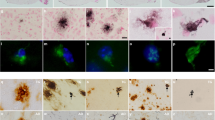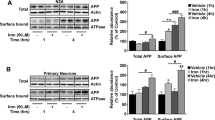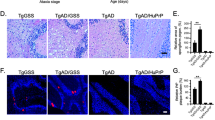Abstract
Several pathogenic Alzheimer's disease (AD) mutations have been described, all of which cause increased amyloid β-protein (Aβ) levels. Here we present studies of a pathogenic amyloid precursor protein (APP) mutation, located within the Aβ sequence at codon 693 (E693G), that causes AD in a Swedish family. Carriers of this 'Arctic' mutation showed decreased Aβ42 and Aβ40 levels in plasma. Additionally, low levels of Aβ42 were detected in conditioned media from cells transfected with APPE693G. Fibrillization studies demonstrated no difference in fibrillization rate, but Aβ with the Arctic mutation formed protofibrils at a much higher rate and in larger quantities than wild-type (wt) Aβ. The finding of increased protofibril formation and decreased Aβ plasma levels in the Arctic AD may reflect an alternative pathogenic mechanism for AD involving rapid Aβ protofibril formation leading to accelerated buildup of insoluble Aβ intra- and/or extracellularly.
This is a preview of subscription content, access via your institution
Access options
Subscribe to this journal
Receive 12 print issues and online access
$209.00 per year
only $17.42 per issue
Buy this article
- Purchase on Springer Link
- Instant access to full article PDF
Prices may be subject to local taxes which are calculated during checkout






Similar content being viewed by others
References
Hardy, J. Amyloid, the presenilins and Alzheimer's disease. Trends Neurosci. 20, 154–159 (1997).
Selkoe, D. J. Translating cell biology into therapeutic advances in Alzheimer's disease. Nature 399, A23–A31 (1999).
Mullan, M. et al. A pathogenic mutation for probable Alzheimer's disease in the APP gene at the N-terminus of β-amyloid. Nature Genet. 1, 345–347 (1992).
Citron, M. et al. Excessive production of amyloid β-protein by peripheral cells of symptomatic and presymptomatic patients carrying the Swedish familial Alzheimer's disease mutation. Proc. Natl. Acad. Sci. USA 91, 11993–11997 (1994).
Johnston, J. A. et al. Increased β-amyloid release and levels of amyloid precursor protein (APP) in fibroblast cell lines from family members with the Swedish Alzheimer's disease APP670/671 mutation. FEBS Lett. 354, 274–278 (1994).
Scheuner, D. et al. Secreted amyloid β-protein similar to that in the senile plaques of Alzheimer's disease is increased in vivo by the presenilin 1 and 2 and APP mutations linked to familial Alzheimer's disease. Nat. Med. 2, 864–869 (1996).
Levy, E. et al. Mutation of the Alzheimer's disease amyloid gene in hereditary cerebral hemorrhage, Dutch type. Science 248, 1124–1126 (1990).
Hendriks, L. et al. Presenile dementia and cerebral haemorrhage linked to a mutation at codon 692 of the β-amyloid precursor protein gene. Nat. Genet. 1, 218–221 (1992).
De Jonghe, C. et al. Flemish and Dutch mutations in amyloid β precursor protein have different effects on amyloid β secretion. Neurobiol. Dis. 5, 281–286 (1998).
Haass, C., Hung, A. Y., Selkoe, D. J. & Teplow, D. B. Mutations associated with a locus for familial Alzheimer's disease result in alternative processing of amyloid β-protein precursor. J. Biol. Chem. 269, 17741–17748 (1994).
Watson, D. J., Selkoe, D. J. & Teplow, D. B. Effects of the amyloid precursor protein Glu693→ Gln 'Dutch' mutation on the production and stability of amyloid β-protein. Biochem. J. 340, 703–709 (1999).
Walsh, D. M., Lomakin, A., Benedek, G. B., Condron, M. M. & Teplow, D. B. Amyloid β-protein fibrillogenesis–detection of protofibrillar intermediate. J. Biol. Chem. 272, 22364–22372 (1997).
Walsh, D. M., Hartley, D. M., Condron, M. M., Selkoe, D. J. & Teplow, D. B. In vitro studies of amyloid β-protein fibril assembly and toxicity provide clues to the aetiology of Flemish variant (Ala692→Gly) Alzheimer's disease. Biochem J. 355, 869–877 (2001).
Tagliavini, F. et al. A new βPP mutation related to hereditary cerebral haemorrhage. Alz. Report 2, S28 (1999).
Grabowski, T. J., Cho, H. S., Vonsattel, J. P. G., Rebeck, G. W. & Greenberg, S. M. Novel amyloid precursor protein mutation in an Iowa family with dementia and severe cerebral amyloid angiopathy. Ann. Neurol. 49, 697–705 (2001).
Hasegawa, K., Yamaguchi, I., Omata, S., Gejyo, F. & Naiki, H. Interaction between Aβ(1–42) and Aβ(1–40) in Alzheimer's β-amyloid fibril formation in vitro. Biochemistry 38, 15514–15521 (1999).
Teplow, D. B. Structural and kinetic features of amyloid β-protein fibrillogenesis. Amyloid 5, 121–142 (1998).
Harper, J. D., Lieber, C. M. & Lansbury P. T. Jr. Atomic force microscopic imaging of seeded fibril formation and fibril branching by the Alzheimer's disease amyloid-β protein. Chem. Biol. 4, 951–959 (1997).
Harper, J. D., Wong, S. S., Lieber, C. M. & Lansbury, P. T. Jr. Observation of metastable Aβ amyloid protofibrils by atomic force microscopy. Chem. Biol. 4, 119–125 (1997).
Lambert, M. P. et al. Diffusible, nonfibrillar ligands derived from Aβ1–42 are potent central nervous system neurotoxins. Proc. Natl. Acad. Sci. USA 95, 6448–6453 (1998).
Walsh, D. M. et al. Amyloid β-protein fibrillogenesis–structure and biological activity of protofibrillar intermediates. J. Biol. Chem. 36, 25945–25952 (1999).
Harper, J. D., Wong, S. S., Lieber, C. M. & Lansbury, P. T. Assembly of Aβ amyloid protofibrils: an in vitro model for a possible early event in Alzheimer's disease. Biochemistry 38, 8972–8980 (1999).
Hartley, D. M. et al. Protofibrillar intermediates of amyloid β-protein induce acute eletrophysiological changes and progressive neurotoxicity in cortical neurons. J. Neurosci. 19, 8876–8884 (1999).
Conway, K. A. et al. Acceleration of oligomerization, not fibrillization, is a shared property of both α-synuclein mutations linked to early-onset Parkinson's disease: implications for pathogenesis and therapy. Proc. Natl. Acad. Sci. USA 97, 571–576 (2000).
Kamino, K. et al. Linkage and mutational analysis of familial Alzheimer disease kindreds for the APP gene region. Am. J. Hum. Genet. 51, 998–1014 (1992).
Suzuki, N. et al. An increased percentage of long amyloid β protein secreted by familial amyloid β protein precursor (βAPP717) mutants. Science 264, 1336–1340 (1994).
Citron, M. et al. Mutation of the β-amyloid precursor protein in familial Alzheimer's disease increases β-protein production. Nature 360, 672–674 (1992).
Citron, M. et al. Mutant presenilins of Alzheimer's disease increase production of 42-residue amyloid β-protein in both transfected cells and transgenic mice. Nat. Med. 3, 67–72 (1997).
Tamaoka, A. et al. Amyloid β protein in plasma from patients with sporadic Alzheimer's disease. J. Neurol. Sci. 15, 65–68 (1996).
Iwatsubo, T. Amyloid β protein in plasma as a diagnostic marker for Alzheimer's disease. Neurobiol. Aging 19, 161–163 (1998).
Mayeux, R. et al. Plasma amyloid β-peptide 1–42 and incipient Alzheimer's disease. Ann. Neurol. 46, 412–416 (1999).
Selkoe, D. J. The cell biology of β-amyloid precursor protein and presenilin in Alzheimer's disease. Trends Cell Biol. 8, 447–453 (1998).
He, W. & Barrow, C.J. The Aβ 3-pyroglutamyl and 11-pyroglutamyl peptides found in senile plaque have greater β-sheet forming and aggregation propensities in vitro than full-length Aβ. Biochemistry 38, 10871–10877 (1999).
Tjernberg, L. O. et al. Arrest of β-amyloid fibril formation by a pentapeptide ligand. J. Biol. Chem. 271, 8545–8548 (1996).
Soto, C., Kindy, M. S., Baumann, M. & Frangione, B. Inhibition of Alzheimer's amyloidosis by peptides that prevent β-sheet conformation. Biochem. Biophys. Res. Commun. 226, 672–680 (1996).
Wilson, C. A., Doms, R. W. & Lee, V. M. Intracellular APP processing and Aβ production in Alzheimer disease. J. Neuropath. Experiment. Neurol. 58, 787–794 (1999).
Gouras, G. K. et al. Intraneuronal Aβ42 accumulation in human brain. Am. J. Pathol. 156, 15–20 (2000).
Harper, J. D. & Lansbury, P. T. Jr. Models of amyloid seeding in Alzheimer's disease and scrapie: mechanistic truth and physiological consequences of the time-dependent solubility of amyloid proteins. Annu. Rev. Biochem. 66, 385–407 (1997).
Klein, W. L., Krafft, G. A. & Finch, C. E. Targeting small Aβ oligomers: the solution to an Alzheimer's disease conundrum? Trends Neurosci. 24, 219–224 (2001).
Forsell, L. & Lannfelt, L. Amyloid precursor protein mutation at codon 713 (Ala→Val) does not cause schizophrenia: non-pathogenic variant found at codon 705 (silent). Neurosci. Lett. 184, 90–93 (1995).
Acknowledgements
We thank G. Arnerup, R. Kaiser, L. Lilius, S. Petrén and D. Yager for scientific support, and L. Tjernberg and colleagues in our department for comments on the manuscript. The following foundations are acknowledged: the Swedish Society for Medical Research, Trygg-Hansa, Stiftelsen för Gamla tjänarinnor, Åke Wibergs stiftelse, Erik Rönnbergs Stiftelse, Stiftelsen Clas Groschinskys minnesfond, Artur Eriksson, Gun & Bertil Stohnes stiftelse, Loo and Hans Ostermans stiftelse för geriatrisk forskning, Ulf Widengrens Minnesfond, Swedish Society for Medicine, the Alzheimer Foundation, the Swedish Medical Research Council (project 10819) and the US National Institutes of Health (grants NS38328 and AG14366 to D.B.T.).
Author information
Authors and Affiliations
Corresponding author
Rights and permissions
About this article
Cite this article
Nilsberth, C., Westlind-Danielsson, A., Eckman, C. et al. The 'Arctic' APP mutation (E693G) causes Alzheimer's disease by enhanced Aβ protofibril formation. Nat Neurosci 4, 887–893 (2001). https://doi.org/10.1038/nn0901-887
Received:
Accepted:
Published:
Issue Date:
DOI: https://doi.org/10.1038/nn0901-887
This article is cited by
-
Anti-amyloid Antibody Therapies for Alzheimer’s Disease
Nuclear Medicine and Molecular Imaging (2024)
-
Anti-Amyloid Monoclonal Antibodies for the Treatment of Alzheimer’s Disease
BioDrugs (2024)
-
Differential effects of familial Alzheimer’s disease-causing mutations on amyloid precursor protein (APP) trafficking, proteolytic conversion, and synaptogenic activity
Acta Neuropathologica Communications (2023)
-
The autophagy protein Def8 is altered in Alzheimer's disease and Aβ42-expressing Drosophila brains
Scientific Reports (2023)
-
Emerging diagnostics and therapeutics for Alzheimer disease
Nature Medicine (2023)



